NZXT Cryo LX Notebook
NZXT Cryo LX Notebook Cooler Mini-Review
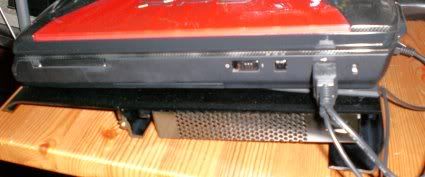 I've become enamored with gaming notebooks, and nowadays, despite the extra expense and the relative lack of upgradeability, I've decided to only buy laptops, and have been doing so for a few years. The thing is, the "hotter" a laptop is, the hotter it is temperature-wise. A notebook cooler is nearly required nowadays.
I've become enamored with gaming notebooks, and nowadays, despite the extra expense and the relative lack of upgradeability, I've decided to only buy laptops, and have been doing so for a few years. The thing is, the "hotter" a laptop is, the hotter it is temperature-wise. A notebook cooler is nearly required nowadays.
Specs on the cooler from NZXT's site:
- Built with thick aluminum with sturdy construction
- Brushed Aluminum finish
- Rubber finish lifts the notebook up to allow less heat pockets and better airflow
- Cools your notebook with three adjustable large 120mm fans
- Four USB ports for your media, storage, and input devices
- Ability to power devices such as external hard drives.
- Folding design for easy storage and transportation
- Support for power notebooks with 15", 17" and 19" wide screens
- Dimensions (W x D): 16.6" x 11.6"
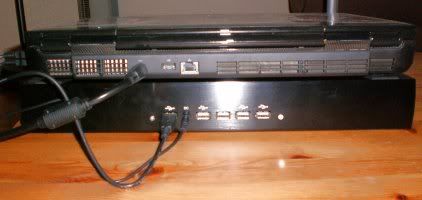 You can see my M1730 fits well on top of the cooler, but the cooler does require two, count 'em two, USB connections. Since the cooler has two ports, you still net two additional ports. You receive one USB cable for data transfer, and one cable that converts from a USB connector to a DC power connection.
You can see my M1730 fits well on top of the cooler, but the cooler does require two, count 'em two, USB connections. Since the cooler has two ports, you still net two additional ports. You receive one USB cable for data transfer, and one cable that converts from a USB connector to a DC power connection.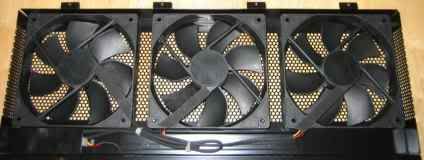 The fans aren't exactly high-speed, but they do move a lot of air. There's a speed control dial on the rear RHS of the cooler. It's not too difficult, if you're a tinkerer, to take the unit apart and replace the fans with other 120mm fans if you'd like.
The fans aren't exactly high-speed, but they do move a lot of air. There's a speed control dial on the rear RHS of the cooler. It's not too difficult, if you're a tinkerer, to take the unit apart and replace the fans with other 120mm fans if you'd like.Which one is right for me?
There are a few steps you can take in order to choose a good notebook cooler for you.
1) The most important thing is the make sure that the vents and fans of the notebook and the notebook cooler align. Raw fan power or CFM (Cubic feet per minute, which is a measure of the volume of air flowing in a system.) is not everything. Alignment of fans and vents will have a bigger role in how effective the cooler is in most cases. Exceptions would be if a notebook does not do well in the presence of any notebook cooler you have tried or if you are having ridiculously high temperatures in specific cases. An example of this would be the Zalman NC1000 versus the Zalman NC2000 debate for a 15.4 inch notebook. After tests were done the lower CFM NC2000 beat out the NC1000 due to the fans and vents being hit better. Here is the link to that article.
Here is an example of how to check alignment.
1) Find the measurements of the vent area or the cooling area of the notebook cooler you are interested in. You could look at reviews or comparisons as they may have measurements already laid out or ask a two or more users of the cooler as they may provide you with the information. The reason you may want to ask two or more users is that one may be biased or they could both have different measurements on what they find to be the area in which airflow comes out and it is recommended if it is the case that two come back with different results find at least one more opinion.
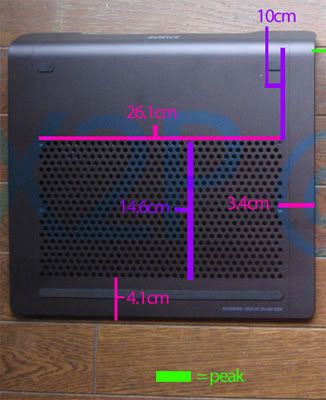
2) Now that you have found the measurements for cooler’s fan/vent location and other measurements flip your notebook over and measure your own vent fan placement. The goal is to see if your notebook will align well with the cooler’s vents. I recommend you take a picture of the bottom and Photoshop or MS Paint the measurements for each location to make it easier for your self after all measurements are taken. If your notebook vents generally hit but only about a centimeter is being missed on top/bottom or both etc it should be fine. (Thank you to the user I have borrowed the image from)
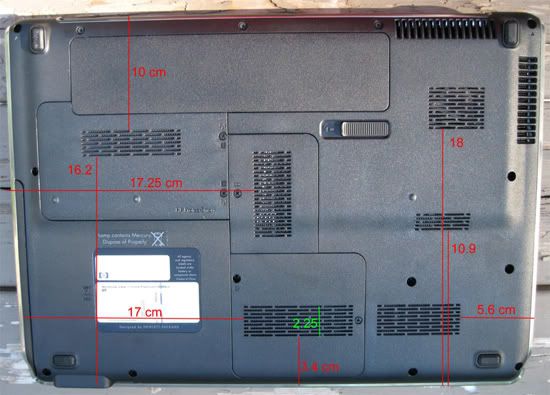
2) Noise. Some do not mind the presence of excess fan noise but there are many who are bothered by almost any noise in general. Many coolers do make a lot of noise but there are some that are quieter then others. One tip is often but note always notebook coolers with higher CFM generate more noise as they either have an extra fan resulting in a 50% raise in noise (mathematically calculating 2 +1 =3, the one is 50% of the 2) or the smaller space in vents to create a higher CFM (Think about blowing through a straw full breath and the noise it would create, now remove the straw and think about that noise which is quieter? No straw).
3) Looks are also important to an extent. Many users want their work space to match and look organized. It is not a good idea if you have an overly sleek notebook such as a new Dell Latitude E and buy a cooler that looks gaming oriented unless it is determined that the cooler will do a far greater job. It would be like taking a Maybach and tossing a racing spoiler on it.

4) Aluminum or a metal in general is a better choice when buying a notebook cooler over plastic for the following reasons. Metal conducts heat, especially aluminum, better then plastic will. Meaning if the contact surface is built out of metal it may provide a better cooling experience. The other advantage of a cooler using its largest surface made out of metal would be strength. Metal is usually stronger than plastic as you should be able to guess.
5) In order to get the best price possible use a site such as:
Canada: www.shopbot.ca
USA: www.pricegrabber.com
Find the lowest price available for the product and find a local store that does price matching. Many stores do this but some require a cash payment in order to allow for price matching.
 RSS Feed
RSS Feed Twitter
Twitter
0 Response to "NZXT Cryo LX Notebook"
Post a Comment
Submit what you know about games.It will be published in
this site